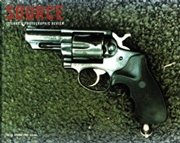Sea of Images
Michael Boran: The Palace of Bubbles - Gallery of Photography February 4th - 27th 1999
Review by Justin Carville
Issue 18 Spring 1999
View Contents ▸
There is always a disparity between interpretation and intentionality. Artists and photographers are, no doubt, frequently perplexed at the types of things viewers say about their work. Reciprocally, viewers are often unsure of the explanations given for the basis of much visual art. Such is the fragility of communication between artist, work and the viewer, that the search ensues to find that one fragment which may pull everything into place and contextualise the experience of engaging with a body of work. Channel Hopping Original in Colour
Channel Hopping Original in Colour
It was while working through this process at Michael Boran's exhibition The Palace of Bubbles at the Gallery of Photography, that I noticed the speed at which other viewers were passing through the show. Some spent maybe just two or three minutes browsing the prints before inspecting the installation 'Exploded Projector' at the far end of the first floor, while others simply walked through to the installation and back out again. I began to wonder if they where instantaneously recognising something in the work that I wasn't. I turned to the obligatory text panel that all the other visitor's to the gallery seemed to briefly study. The first paragraph of this text confirmed what can be surmised from the brevity of the other gallery goers visits to the show. This is a piece of work which is unsure of the direction it should be taking.
The closing part of this first paragraph highlights the extent of this unsureness, The Palace of Bubbles we are told, combines 'serious metaphysical concerns about time and temporality with a truly delightful exuberance'. This elusive explanation clearly does not help matters. In an attempt to justify the work with the serious intent of the artist, against the pleasure of experiencing the show, the uncertainty of the work's place in the gallery seeps through. Sure, the connections of photography, bubbles and cell life with temporality are clearly made. The time exposure of photography and the immutability of the photographic image belies its ephemeral subject matter and their references to the fragility of cell life. Photographs are, of course, about the mapping of time, an aspect of photography often disregarded in favour of photography's indexical qualities. One can't help but feel however, that the claims of the exploration of time in this work are slightly tenuous.
Boran's 30x40 inch cibacromes in the main gallery space, all 66 of them, are visually engaging. The images are vibrant and easy to consume. There should be a simple pleasure in the experience of viewing these images, however a number of factors conspire against this. Firstly there is a degree of scepticism in the process of trying to justify the work through the seriousness of intent. Secondly the wall chart listing image titles ranging from 'The Truth of Certainty', 'Antibody' and 'Free Radical' to 'Bubbles O'Sùille' and 'Bubbles abhaìn', far from appearing playful merely confirm a hesitancy in the work. The references to popular notions of science and genetics hint at something more promising than the images themselves. Parting the Horse's Mane Original in Colour
Parting the Horse's Mane Original in Colour
Finally, the sheer volume of images in such a small space detracts from some of the more interesting individual prints. A number of the cibacrome prints do suggest some interesting perspectives on the processes of photography. One image in particular, 'Macula' stands out. The burned out colour print with a slightly solarised image of a Georgian building alludes to the photographic process itself. The printing or burning through of the image suggests the extending of time in the process of image production. Prints such as this one however, are lost in the sea of images on the congested gallery walls and fail to make the impact they possibly deserve.
The various installation projection pieces such as '80 Watts', 'Exploded Projector' and 'Bubble Projectile' do not work well in the gallery's smaller spaces, and detract further from some of the more promising individual works. The Seven dyeline prints on the upper balcony do stand out, and sit with the rest of the work much more comfortably than the installation work. There are some engaging individual images here but the congested walls of the gallery simply don't provide the space required to make any sort of impact.
Other articles by Justin Carville:
Issue 24: Will the Real History of Photography Please Stand Up? [Feature] ▸
Issue 27: The History of the Solitary Lighthouse Keeper [Review] ▸
Issue 27: Each Wild Idea: Writing, Photography, History by Geoffrey Batchen [Book Review] ▸






